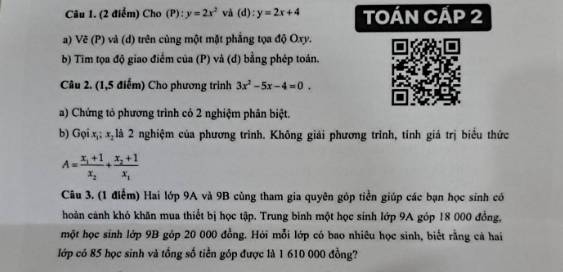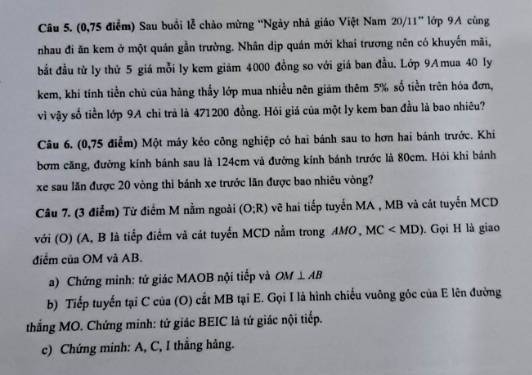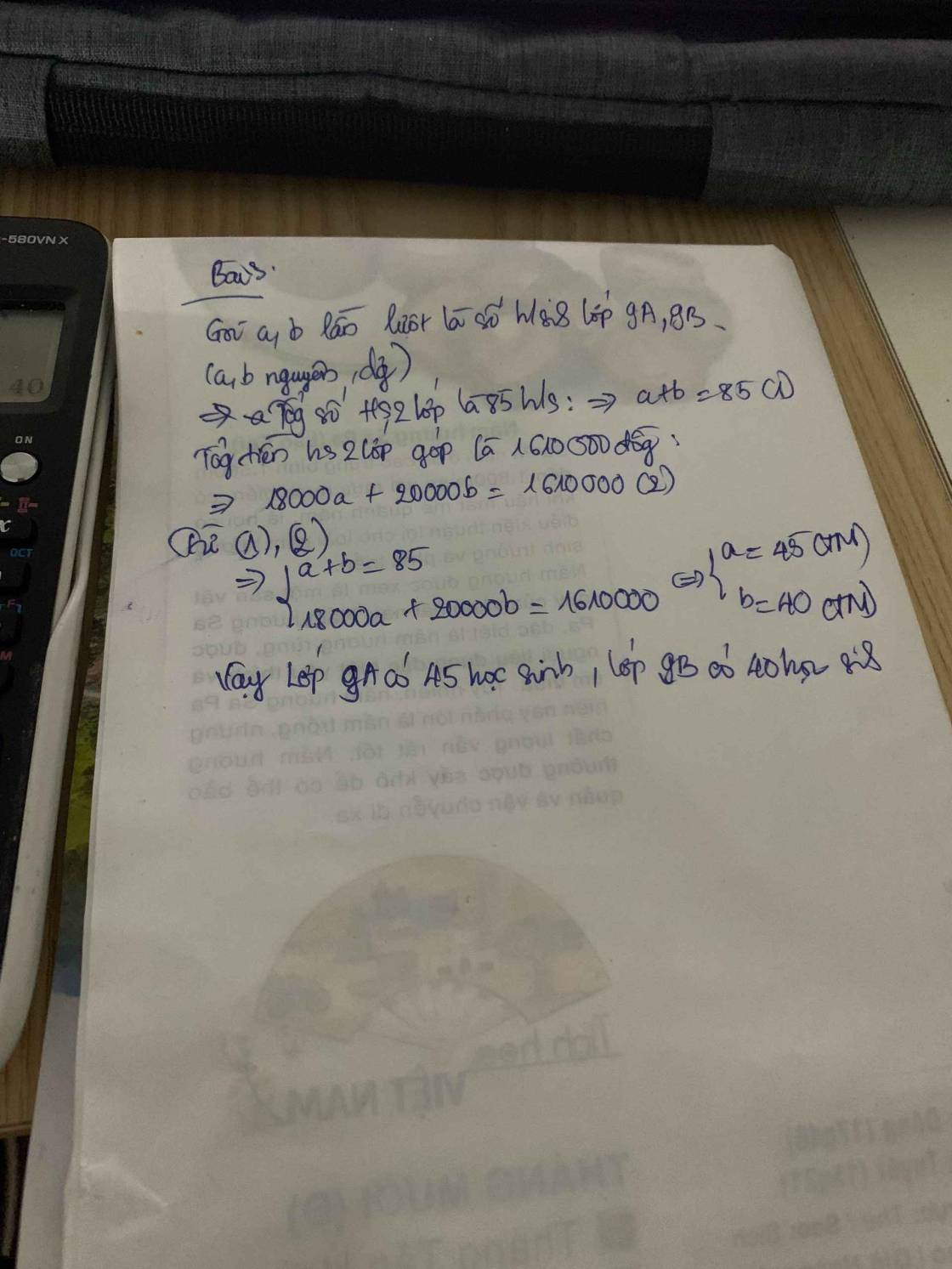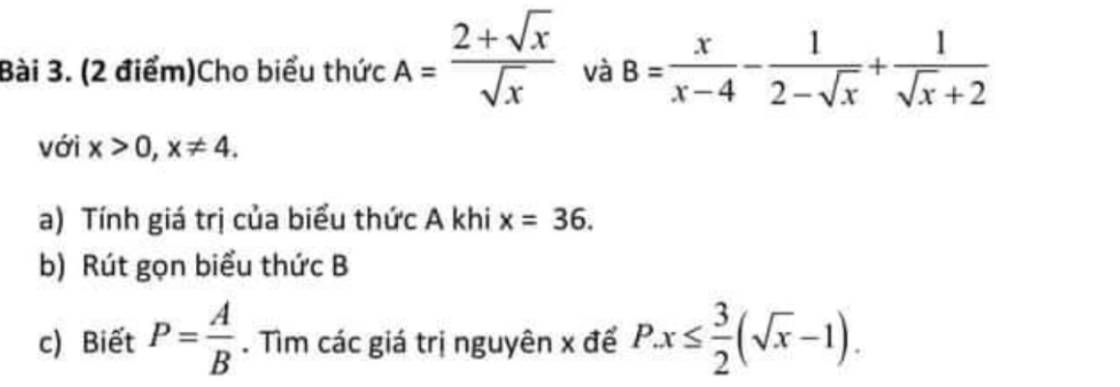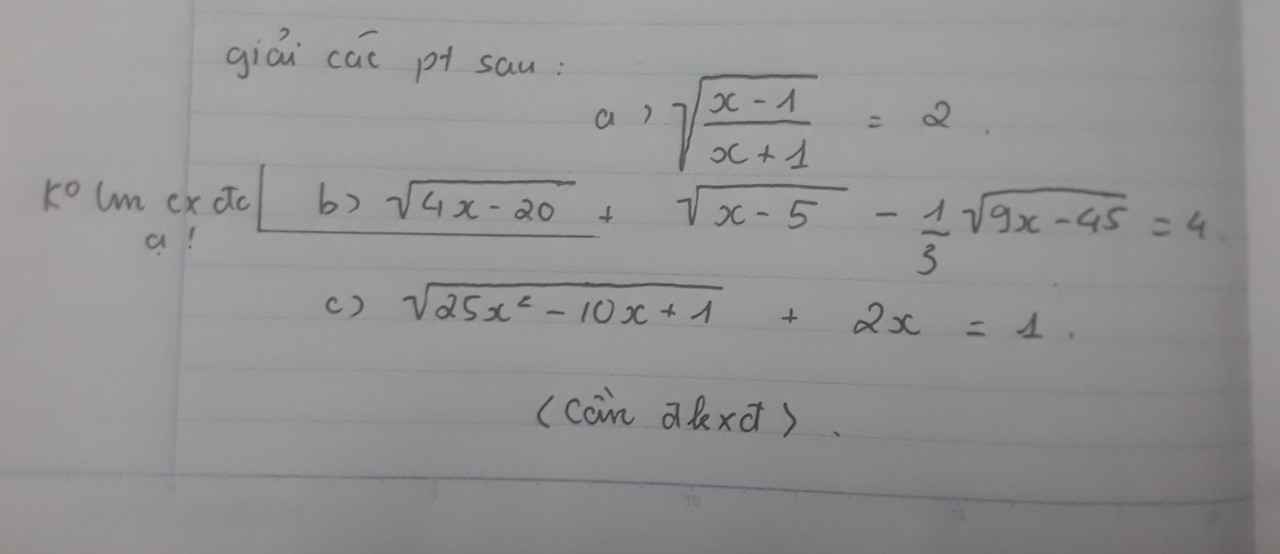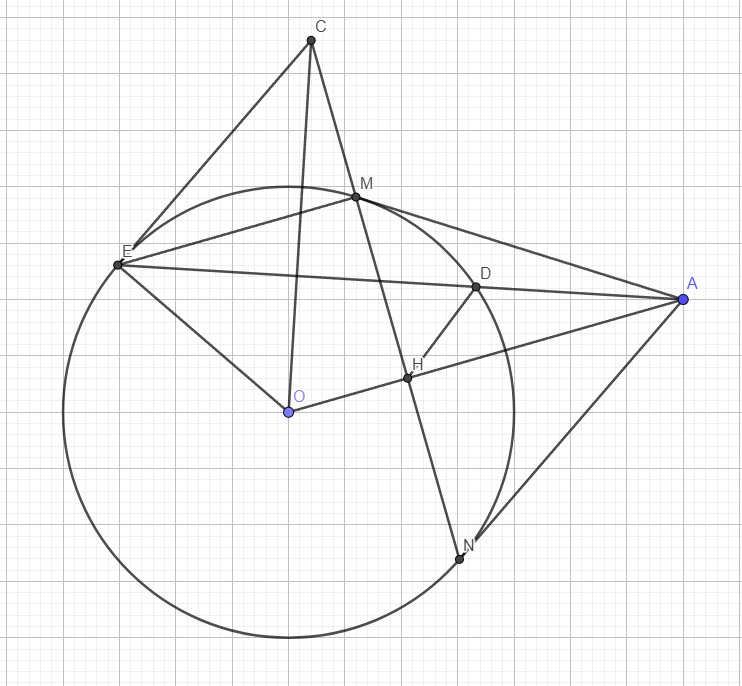
Hãy nhập câu hỏi của bạn vào đây, nếu là tài khoản VIP, bạn sẽ được ưu tiên trả lời.


\(\Delta=\left(2m+3\right)^2+4\left(2m+4\right)=4m^2+20m+25=\left(2m+5\right)^2\ge0;\forall m\)
Pt đã cho luôn có 2 nghiệm với mọi m
Theo hệ thức Viet: \(\left\{{}\begin{matrix}x_1+x_2=2m-3\\x_1x_2=-2m-4\end{matrix}\right.\)
\(\left|x_1\right|+\left|x_2\right|=5\Leftrightarrow x_1^2+x_2^2+2\left|x_1x_2\right|=25\)
\(\Leftrightarrow\left(x_1+x_2\right)^2-2x_1x_2+2\left|x_1x_2\right|=25\)
\(\Leftrightarrow\left(2m-3\right)^2+2\left(2m+4\right)+2\left|2m+4\right|=25\)
\(\Leftrightarrow4m^2-8m-8+4\left|m+2\right|=0\)
TH1: \(m\ge-2\)
\(\Rightarrow4m^2-8m-8+4\left(m+2\right)=0\)
\(\Leftrightarrow4m^2-4m=0\Rightarrow\left[{}\begin{matrix}m=0\\m=1\end{matrix}\right.\) (thỏa mãn)
TH2: \(m\le-2\)
\(\Rightarrow4m^2-8m-8-4\left(m+2\right)=0\)
\(\Leftrightarrow4m^2-12m-16=0\Rightarrow\left[{}\begin{matrix}m=-1\left(loại\right)\\m=4\left(loại\right)\end{matrix}\right.\)

\(a,x=36\Leftrightarrow A=\dfrac{2+\sqrt{36}}{\sqrt{36}}=\dfrac{2+6}{6}=\dfrac{4}{3}\)
\(b,B=\dfrac{x}{x-4}-\dfrac{1}{2-\sqrt{x}}+\dfrac{1}{\sqrt{x}+2}\left(dkxd:x>0,x\ne4\right)\\ =\dfrac{x}{\left(\sqrt{x}-2\right)\left(\sqrt{x}+2\right)}+\dfrac{1}{\sqrt{x}-2}+\dfrac{1}{\sqrt{x}+2}\\ =\dfrac{x+\sqrt{x}+2+\sqrt{x}-2}{x-4}\\ =\dfrac{x+2\sqrt{x}}{x-4}\\ =\dfrac{\sqrt{x}\left(\sqrt{x}+2\right)}{\left(\sqrt{x}-2\right)\left(\sqrt{x}+2\right)}\\ =\dfrac{\sqrt{x}}{\sqrt{x}-2}\)
\(c,P=\dfrac{A}{B}=\dfrac{2+\sqrt{x}}{\sqrt{x}}.\dfrac{\sqrt{x}-2}{\sqrt{x}}=\dfrac{x-4}{x}\)
Để \(Px\le\dfrac{3}{2}\left(\sqrt{x}-1\right)\) thì \(\dfrac{x-4}{x}.x\le\dfrac{3}{2}\left(\sqrt{x}-1\right)\)
\(\Leftrightarrow x-4-\dfrac{3}{2}\sqrt{x}+\dfrac{3}{2}\le0\\ \Leftrightarrow x-\dfrac{3}{2}\sqrt{x}-\dfrac{5}{2}\le0\)
\(\Leftrightarrow x\le\dfrac{25}{4}\)
Kết hợp với điều kiện \(x>0,x\ne4,x\in Z\), ta kết luận \(S=\left\{1;2;3;5;6\right\}\)

a)\(đkx\ge1,x\ne-1\)
\(\sqrt{\dfrac{x-1}{x+1}}=2\)
\(\Leftrightarrow\dfrac{x-1}{x+1}=4\)
\(\Leftrightarrow x-1=4x-4\)
\(\Leftrightarrow x=1\)(nhận)
Vậy S=\(\left\{1\right\}\)
c)đk\(25x^2-10x+1=\) \(\left(5x-1\right)^2\ge0\Leftrightarrow x\ge\dfrac{1}{5}\)
\(\sqrt{25x^2-10x+1}+2x=1\)
\(\Leftrightarrow\sqrt{\left(5x-1\right)^2}+2x=1\)
\(\Leftrightarrow5x-1+2x=1\)
\(\Leftrightarrow x=\dfrac{2}{7}\)(nhận)
Vậy S=\(\left\{\dfrac{2}{7}\right\}\)
c: Ta có: \(\sqrt{25x^2-10x+1}+2x=1\)
\(\Leftrightarrow\left|5x-1\right|=1-2x\)
\(\Leftrightarrow\left[{}\begin{matrix}5x-1=1-2x\left(x\ge\dfrac{1}{5}\right)\\5x-1=2x-1\left(x< \dfrac{1}{5}\right)\end{matrix}\right.\Leftrightarrow\left[{}\begin{matrix}x=\dfrac{2}{7}\left(nhận\right)\\x=0\left(nhận\right)\end{matrix}\right.\)

d.
Từ câu b ta có: \(\dfrac{AD}{AO}=\dfrac{AH}{AE}\)
Xét 2 tam giác ADH và AOE có: \(\left\{{}\begin{matrix}\widehat{HAD}\text{ chung}\\\dfrac{AD}{AO}=\dfrac{AH}{AE}\end{matrix}\right.\)
\(\Rightarrow\Delta ADH\sim\Delta AOE\left(c.g.c\right)\Rightarrow\widehat{AHD}=\widehat{AEO}\)
Mà \(\widehat{AHD}+\widehat{DHO}=180^0\Rightarrow\widehat{AEO}+\widehat{DHO}=180^0\)
\(\Rightarrow\) Tứ giác DHOE nội tiếp
Lại có E và H cùng nhìn OC dưới 1 góc vuông \(\Rightarrow CHOE\) nội tiếp đường tròn đường kính OC
\(\Rightarrow C,D,H,O,E\) cùng thuộc đường tròn đường kính OC
\(\Rightarrow\widehat{CDO}\) là góc nt chắn nửa đường tròn (do OC là đường kính)
\(\Rightarrow CD\perp OD\)
\(\Rightarrow CD\) là tiếp tuyến của (O) tại D
\(\Rightarrow C\) là giao điểm 2 tiếp tuyến của (O) tại D và E
\(\Rightarrow CE=CD\) (t/c 2 tiếp tuyến cắt nhau)
Mà \(OD=OE=R\)
\(\Rightarrow OC\) là trung trực của DE \(\Rightarrow OC\perp DE\)
Theo gt I là trung điểm DE \(\Rightarrow OI\perp DE\)
\(\Rightarrow\)Đường thẳng OC trùng đường thẳng OC\(\Rightarrow O,I,C\) thẳng hàng

Câu 1:
1:
a: \(\dfrac{1}{2}x-3=0\)
=>\(\dfrac{1}{2}x=3\)
=>\(x=3:\dfrac{1}{2}=3\cdot2=6\)
b: \(3x^2-12x=0\)
=>\(3x\cdot x-3x\cdot4=0\)
=>\(3x\left(x-4\right)=0\)
=>x(x-4)=0
=>\(\left[{}\begin{matrix}x=0\\x-4=0\end{matrix}\right.\Leftrightarrow\left[{}\begin{matrix}x=0\\x=4\end{matrix}\right.\)
2:
a: Phương trình hoành độ giao điểm là:
\(\dfrac{1}{2}x^2=-x+\dfrac{3}{2}\)
=>\(x^2=-2x+3\)
=>\(x^2+2x-3=0\)
=>(x+3)(x-1)=0
=>\(\left[{}\begin{matrix}x+3=0\\x-1=0\end{matrix}\right.\Leftrightarrow\left[{}\begin{matrix}x=-3\\x=1\end{matrix}\right.\)
Khi x=-3 thì \(y=\dfrac{1}{2}\cdot\left(-3\right)^2=\dfrac{1}{2}\cdot9=4,5\)
Khi x=1 thì \(y=\dfrac{1}{2}\cdot1^2=\dfrac{1}{2}\)
b: Gọi (d1): y=ax+b(a<>0) là phương trình đường thẳng cần tìm
Thay x=2 và y=2 vào (d), ta được:
\(a\cdot2+b=2\)
=>2a+b=2
=>b=2-2a
=>y=ax+2-2a
Phương trình hoành độ giao điểm là:
\(\dfrac{1}{2}x^2=ax+2-2a\)
=>\(\dfrac{1}{2}x^2-ax-2+2a=0\)
\(\text{Δ}=\left(-a\right)^2-4\cdot\dfrac{1}{2}\cdot\left(2a-2\right)\)
\(=a^2-2\left(2a-2\right)=a^2-4a+4=\left(a-2\right)^2\)
Để (P) tiếp xúc với (d1) thì Δ=0
=>a-2=0
=>a=2
=>b=2-2a=2-4=-2
Vậy: Phương trình đường thẳng cần tìm là y=2x-2




